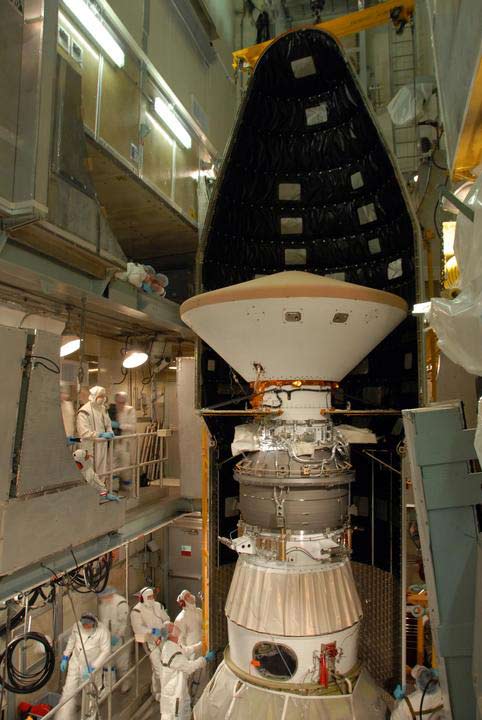NASA's Phoenix Mars Probe Set for Saturday Launch

A new NASA probedestined to dig into the arctic northern plains of Mars is on track for itsplanned Saturday launch, mission managers said Thursday.
Perchedatop its 13-story Delta 2 rocket, NASA'sPhoenix Mars lander is set to launch towards the red planet at 5:26:34 a.m.EDT (0926:34 GMT) during the first of two possible Saturday attempts fromFlorida's Cape Canaveral Air Force Station.
"For summertime in Florida, that is about the best time of day you can launch," said U.S.Air Force Delta 2 launch weather officer Joel Tumbiolo in a Thursday briefing atNASA's Kennedy Space Center in Cape Canaveral.
Current weatherforecasts offer an 80 percent chance of favorable conditions during Phoenix'sfirst launch opportunity, as well a second window that opens at 6:02:59 a.m.EDT (1002:59 GMT), Tumbiolo added. About the only weather concern is thepossibility of thick clouds near the Mars probe's launch site, he added.
The $420million Phoenix lander carries a mix of new science tools and recycled instrumentsoriginally designed for NASA's ill-fated 1999Mars Polar Lander and the canceled Mars Surveyor 2001 missions. The planned90-day mission, researchers hope, will unlock secrets hidden within the redplanet's subsurface ice and soil near its north pole, and shed light on whetherthe region could have once been habitable.
"Ourinstruments are specially designed to find evidence for periodic melting of theice and to assess whether this large region represents a habitable environmentfor Martian microbes," Phoenix principal investigator Peter Smith, of the Universityof Arizona, said of the mission's planned landing zone. ?
Phoenixcarries seven primary experiment packages, including an eight-foot (2.4-meter) roboticarm designed to scoop up martian soil and ice like a backhoe. It also carriestiny, deck-mounted ovens and other instruments to sift for signs of organiccompounds within the martian soil, as well as a suite of Mars weathermonitoring tools.
Get the Space.com Newsletter
Breaking space news, the latest updates on rocket launches, skywatching events and more!
If all goeswell, Phoenix is expected to land on May 25, 2008 in a flat region known asVastitas Borealis at a northern Mars latitude that is comparable to those ofnorthern Alaska, Greenland or Siberia on Earth, mission managers have said.
Phoenix'sdescent to the martian surface, which relies on parachutes and a series ofpulse rocket thrusters, will mark NASA's first soft landing on Mars since the Vikingmissions of the 1970s.
NASA launchdirector Chuck Dovale said engineers are currently analyzing the impact of adropout in air conditioning around the protective, shroud-like launch fairing envelopingPhoenix atop its Delta 2 rocket, but the glitch is not expected to be a problemfor Saturday's planned liftoff.
Originallyslated for an Aug. 3 launch, Phoenix's Earth departure was delayedearlier this week after bad weather prevented the second stagefueling of the probe's Delta 2 rocket. NASA has a 22-day launch window to sendPhoenix off towards Mars that closes Aug. 24. Beyond that, the space agencywould have to wait 26 months - just over two years - for Mars and Earth to onceagain return to the proper orbital alignment for the mission.
With such arestricted launch window NASA officials have said they would consider delayingthe plannedAug. 7 launch of the space shuttle Endeavour from KSC to offer more flightopportunities for Phoenix.
"Wehave a three-week launch window, which is quite an extensive period,"Deborah Bass, NASA's deputy project scientist for Phoenix at JPL, toldreporters Wednesday during a series of interviews on NASA TV. "I feelconfident that we?ll get off Earth and on towards Mars within that time."
- VIDEO: Looking for Life in All the Right Places
- Top 10 Amazing Discoveries by NASA's Mars Rovers
- Image Gallery: Visualizations of Mars
Join our Space Forums to keep talking space on the latest missions, night sky and more! And if you have a news tip, correction or comment, let us know at: community@space.com.

Tariq is the Editor-in-Chief of Space.com and joined the team in 2001, first as an intern and staff writer, and later as an editor. He covers human spaceflight, exploration and space science, as well as skywatching and entertainment. He became Space.com's Managing Editor in 2009 and Editor-in-Chief in 2019. Before joining Space.com, Tariq was a staff reporter for The Los Angeles Times covering education and city beats in La Habra, Fullerton and Huntington Beach. In October 2022, Tariq received the Harry Kolcum Award for excellence in space reporting from the National Space Club Florida Committee. He is also an Eagle Scout (yes, he has the Space Exploration merit badge) and went to Space Camp four times as a kid and a fifth time as an adult. He has journalism degrees from the University of Southern California and New York University. You can find Tariq at Space.com and as the co-host to the This Week In Space podcast with space historian Rod Pyle on the TWiT network. To see his latest project, you can follow Tariq on Twitter @tariqjmalik.
